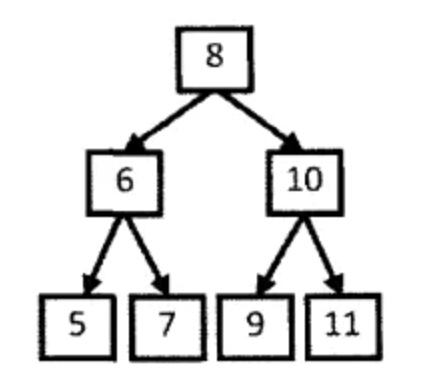数据结构 Tree 二叉查找树
参考资料 二叉搜索树 LeetCode
二叉搜索树的定义
二叉搜索树(Binary Search Tree)是二叉树的一种特殊形式。 二叉搜索树具有以下性质:每个节点中的值必须大于(或等于)其左侧子树中的任何值,但小于(或等于)其右侧子树中的任何值。
二叉搜索树(BST)是二叉树的一种特殊表示形式,它满足如下特性:
- 每个节点中的值必须大于(或等于)存储在其左侧子树中的任何值。
- 每个节点中的值必须小于(或等于)存储在其右子树中的任何值。
下面是一个二叉搜索树的例子:

像普通的二叉树一样,可以按照前序、中序和后序来遍历一个二叉搜索树。 但是值得注意的是,对于二叉搜索树,我们可以通过中序遍历得到一个递增的有序序列。因此,中序遍历是二叉搜索树中最常用的遍历方法。
测试工具
生成一颗二叉搜索树
/**
* 生成一颗二叉搜索树
*/
public static TreeNode generateBSTree(int len) {
int[] arr = new int[len];
for (int i = 0; i < arr.length; i++) {
arr[i] = i;
}
return buildBSTree(arr, 0, arr.length - 1);
}
/**
* 构建二叉搜索树
*/
private static TreeNode buildBSTree(int[] nums, int lo, int hi) {
if (lo > hi) {
return null;
}
// 以升序数组的中间元素作为根节点 root。
int mid = lo + (hi - lo) / 2;
TreeNode root = new TreeNode(nums[mid]);
// 递归的构建 root 的左子树与右子树。
root.left = buildBSTree(nums, lo, mid - 1);
root.right = buildBSTree(nums, mid + 1, hi);
return root;
}
使用:
TreeNode root = generateBSTree(14);
有序数组构建一颗二叉搜索树
/**
* 生成一颗二叉搜索树(这里其实只是生成一个排序数组,核心是第二个方法)
*/
public static TreeNode generateBSTree(int len) {
int[] arr = new int[len];
for (int i = 0; i < arr.length; i++) {
arr[i] = i;
}
return buildBSTree(arr, 0, arr.length -1);
}
/**
* 构建二叉搜索树
*/
private static TreeNode buildBSTree(int[] nums, int lo, int hi) {
if (lo > hi) {
return null;
}
// 以升序数组的中间元素作为根节点 root。
int mid = lo + (hi - lo) / 2;
TreeNode root = new TreeNode(nums[mid]);
// 递归的构建 root 的左子树与右子树。
root.left = buildBSTree(nums, lo, mid - 1);
root.right = buildBSTree(nums, mid + 1, hi);
return root;
}
验证二叉搜索树 ⭐
给定一个二叉树,判断其是否是一个有效的二叉搜索树。
假设一个二叉搜索树具有如下特征:
- 节点的左子树只包含小于当前节点的数。
- 节点的右子树只包含大于当前节点的数。
- 所有左子树和右子树自身必须也是二叉搜索树。
示例 1:
输入:
2
/ \
1 3
输出: true
示例 2:
输入:
5
/ \
1 4
/ \
3 6
输出: false
解释: 输入为: [5,1,4,null,null,3,6]。
根节点的值为 5 ,但是其右子节点值为 4 。
这题很简单,直接使用 中序遍历 就行,使用中序遍历可以发现它是逐步升序的,如果某个节点比之前那个小就不是二叉搜索树
使用递归的方式
/**
* 判断是否为二叉搜索树
*/
public static boolean isBST(TreeNode head, int max) {
if (head == null) return true;
if (head.left != null) return isBST(head.left, max);
if (head.value <= max) {
return false;
} else {
max = head.value;
}
if (head.right != null) return isBST(head.right, max);
return true;
}
使用:
System.out.println(isBST(root, Integer.MIN_VALUE));
使用迭代的方式
/**
* 判断是否为二叉搜索树
*/
public static boolean isBST(TreeNode head) {
if (head == null) return true;
Stack<TreeNode> stack = new Stack<>();
int max = Integer.MIN_VALUE;
while (!stack.isEmpty() || head != null) {
if (head != null) {
stack.push(head);
head = head.left;
} else {
head = stack.pop();
// 这里判断大小
if (head.value <= max) {
return false;
} else {
max = head.value;
}
head = head.right;
}
}
return true;
}
使用 DP 解(DP 法)⭐
- 左树得是搜索二叉树
- 右树得是搜索二叉树
- 左树最大值小于 Root 节点的值
- 右树最小值大于 Root 节点的值
所以它向它的左树需要什么信息?
- 左树是否是搜索二叉树
- 然后左树的最大值
它向它的右树需要什么信息?
- 右树是否是搜索二叉树
- 右树的最小值
总结一下:整个判断只需用大下面三个信息:
- 最大值是什么?
- 最小值是什么?
- 是否是搜索二叉树?
算法如下:
/**
* 判断是否为二叉搜索树
*/
public static boolean isBST(TreeNode head) {
return process(head).isBST;
}
/**
* 返回 Data 这里存了需要的三个信息
*/
public static class ReturnData {
boolean isBST;
int max;
int min;
public ReturnData(boolean isBST, int max, int min) {
this.isBST = isBST;
this.max = max;
this.min = min;
}
}
public static ReturnData process(TreeNode x) {
if (x == null) return null;
// 这里其实就是拆黑盒的过程,不用管它怎么拿到的
ReturnData leftData = process(x.left);
ReturnData rightData = process(x.right);
// 返回的三个信息
int min = x.value;
int max = x.value;
// 这里的 min 主要取得最小值
if (leftData != null) {
min = Math.min(min, leftData.min);
max = Math.max(max, leftData.max);
}
// 这里的 max 主要取得最大值
if (rightData != null) {
min = Math.min(min, rightData.min);
max = Math.max(max, rightData.max);
}
boolean isBST = true;
// 这里就是主要的判断条件
if (leftData != null && (!leftData.isBST || leftData.max >= x.value)) isBST = false;
if (rightData != null && (!rightData.isBST || rightData.min <= x.value)) isBST = false;
// 把三个信息传递出去
return new ReturnData(isBST, min, max);
}
其实就是一种 DP(动态规划)的过程,把需要的结果传递出去
所以遇到需要从左树取信息,右树取信息的题目就可以使用这个方法来解
算法题
二叉搜索树的后序遍历序列
输入一个整数数组,判断该数组是不是某二叉搜索树的后序遍历的结果。如果是则返回 true,否则返回 false。假设输入的数组的任意两个数字都互不相同。(ps:我们约定空树不是二叉搜素树)
输入:
[4,8,6,12,16,14,10]
返回值
true
解析:一颗二叉搜索树(就是二叉查找树),如下所示

后序遍历为:
[5,7,6,9,11,10,8]
由后序遍历,已经右数一定比 Root 大的特性,只需遍历这个数组,找到第一个比 8 大的下标,将其分成左右子树,按照这种方式,不断的递归。
如果遍历的过程中,先出现了大于根节点的节点,后面又出现了小于根节点的节点,则说明不是二叉搜索树的后序遍历序列。比如 [7,4,6,5] 这样的序列。
class Solution {
// 要点:二叉搜索树中根节点的值大于左子树中的任何一个节点的值,小于右子树中任何一个节点的值,子树也是
public boolean verifyPostorder(int[] postorder) {
if (postorder.length < 2) return true;
return verify(postorder, 0, postorder.length - 1);
}
// 递归实现
private boolean verify(int[] postorder, int left, int right){
if (left >= right) return true; // 当前区域不合法的时候直接返回true就好
int rootValue = postorder[right]; // 当前树的根节点的值
int k = left;
while (k < right && postorder[k] < rootValue){ // 从当前区域找到第一个大于根节点的,说明后续区域数值都在右子树中
k++;
}
for (int i = k; i < right; i++){ // 进行判断后续的区域是否所有的值都是大于当前的根节点,如果出现小于的值就直接返回false
if (postorder[i] < rootValue) return false;
}
// 当前树没问题就检查左右子树
if (!verify(postorder, left, k - 1)) return false; // 检查左子树
if (!verify(postorder, k, right - 1)) return false; // 检查右子树
return true; // 最终都没问题就返回true
}
}
二叉搜索树的第k个结点
这题主要就是考察二叉搜索树的中序遍历就是排序后的队列,以及迭代的方式中序遍历
import java.util.*;
/*
public class TreeNode {
int val = 0;
TreeNode left = null;
TreeNode right = null;
public TreeNode(int val) {
this.val = val;
}
}
*/
public class Solution {
// 因为是二叉搜索树,所以就是中序遍历的顺序
TreeNode KthNode(TreeNode pRoot, int k) {
if (pRoot == null || k == 0) return null;
Stack<TreeNode> stack = new Stack<>();
int count = 0;
while (!stack.isEmpty() || pRoot != null) {
while (pRoot != null) {
stack.push(pRoot);
pRoot = pRoot.left;
}
// 取得最左的第一个元素
TreeNode node = stack.pop();
if (++count == k) return node;
// 指向右边的节点(就算为空也有 Stack 的内容)
pRoot = node.right;
}
return null;
}
}